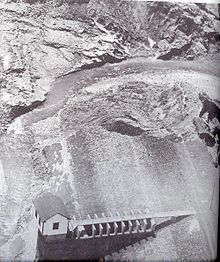
A dam is a barrier that stops or restricts the flow of surface water or underground streams. Reservoirs created by dams not only suppress floods but also provide water for activities such as irrigation, human consumption, industrial use, aquaculture, and navigability. Hydropower is often used in conjunction with dams to generate electricity. A dam can also be used to collect or store water which can be evenly distributed between locations. Dams generally serve the primary purpose of retaining water, while other structures such as floodgates or levees are used to manage or prevent water flow into specific land regions. The earliest known dam is the Jawa Dam in Jordan, dating to 3,000 BC.

The Johnstown Flood occurred on Friday, May 31, 1889, after the catastrophic failure of the South Fork Dam, located on the south fork of the Little Conemaugh River, 14 miles (23 km) upstream of the town of Johnstown, Pennsylvania, United States. The dam ruptured after several days of extremely heavy rainfall, releasing 14.55 million cubic meters of water. With a volumetric flow rate that temporarily equaled the average flow rate of the Mississippi River, the flood killed 2,209 people and accounted for $17 million of damage.

Johnstown Flood National Memorial commemorates the more than 2,200 people who died and the thousands injured in the Johnstown Flood on May 31, 1889. The flood was caused by a break in the South Fork Dam, an earthen structure known to be structurally lacking. The memorial is located at 733 Lake Road near South Fork, Pennsylvania, about 10 miles (16 km) northeast of Johnstown, Pennsylvania. The memorial preserves the remains of the dam and portions of the former Lake Conemaugh bed, along with the farm of Elias Unger and the clubhouse of the South Fork Fishing and Hunting Club which owned the dam and reservoir. Hiking trails connect various parts of the memorial, and picnicking areas are present throughout. The United States Congress authorized the national memorial on August 31, 1964.

Kelly Barnes Dam was an earthen embankment dam in Stephens County, Georgia, just outside the city of Toccoa. Heavy rainfall caused it to collapse on November 6, 1977, and the resulting flood killed 39 people and caused $2.8 million in damage. The dam was never rebuilt.
The Banqiao Reservoir Dam is a dam on the River Ru (汝河), a tributary of the Hong River in Zhumadian City, Henan province, China. The Banqiao dam and Shimantan Reservoir Dam are among 62 dams in Zhumadian that failed catastrophically in 1975 during Typhoon Nina. The dam was subsequently rebuilt.
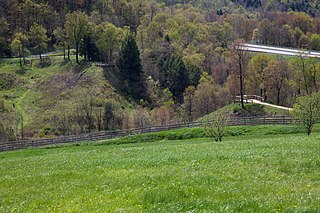
The South Fork Dam was an earthenwork dam forming Lake Conemaugh, an artificial body of water near South Fork, Pennsylvania, United States. On May 31, 1889, the South Fork Dam failed catastrophically and 20 million tons of water from Lake Conemaugh burst, through and raced 14 miles (23 km) downstream, causing the Johnstown Flood.

Lawn Lake Dam was an earthen dam in Rocky Mountain National Park, United States that failed on July 15, 1982, at about 6 a.m., in an event known as the flood of 1982. The sudden release of 30 million cubic feet of water resulted in a flash flood that killed three people camping in the park and caused $31 million in damage to the town of Estes Park, Colorado and other downstream areas.
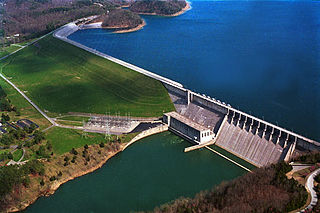
The Wolf Creek Dam is a multi-purpose dam on the Cumberland River in the western part of Russell County, Kentucky, United States. The dam serves at once four distinct purposes: it generates hydroelectricity; it regulates and limits flooding; it releases stored water to permit year-round navigation on the lower Cumberland River; and it creates Lake Cumberland for recreation, which has become a popular tourist attraction. Because of seepage problems in the dam's foundation, it has become the U.S. Army Corps of Engineers's top dam priority. U.S. Route 127 is built on top of the dam.

The South Fork Fishing and Hunting Club was a Pennsylvania corporation which operated an exclusive and secretive retreat at a mountain lake near South Fork, Pennsylvania, for more than fifty extremely wealthy men and their families. The club was the owner of the South Fork Dam, which failed during an unprecedented period of heavy rains, resulting in the disastrous Johnstown Flood on May 31, 1889.

Auburn Dam was a proposed concrete arch dam on the North Fork of the American River east of the town of Auburn, California, in the United States, on the border of Placer and El Dorado Counties. Slated to be completed in the 1970s by the U.S. Bureau of Reclamation, it would have been the tallest concrete dam in California and one of the tallest in the United States, at a height of 680 feet (210 m) and storing 2,300,000 acre-feet (2.8 km3) of water. Straddling a gorge downstream of the confluence of the North and Middle Forks of the American River and upstream of Folsom Lake, it would have regulated water flow and provided flood control in the American River basin as part of Reclamation's immense Central Valley Project.

A dam failure or dam burst is a catastrophic type of structural failure characterized by the sudden, rapid, and uncontrolled release of impounded water or the likelihood of such an uncontrolled release. Between the years 2000 and 2009 more than 200 notable dam failures happened worldwide.

Guajataca Lake, or Lago Guajataca, is a reservoir of the Guajataca River created by the Puerto Rico Electric Power Authority in 1929. It is located between the municipalities of San Sebastián, Quebradillas, and Isabela in Puerto Rico, and receives most of its water from the Rio Guajataca and Rio Chiquito de Cibao rivers. The lake primarily functions as a water reservoir as well as for recreational activities such as boating and fishing. Various species of fish such Peacock Bass, Large Mouth Bass, Sunfish, Perch, Catfish, Tilapia and Threadfin Shad can be found in the lake. The Guajataka Scout Reservation partially borders the southern portion of the lake. The dam at Guajataca Lake experienced a structural failure on September 22, 2017, due to the hit from Hurricane Maria.
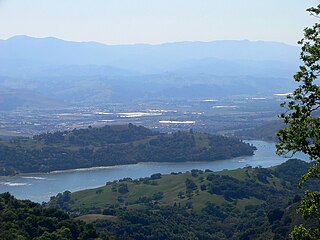
Anderson Lake, also known as Anderson Reservoir, is an artificial lake in Morgan Hill, located in southern Santa Clara County, California. The reservoir is formed by the damming of Coyote Creek just below its confluence with Las Animas Creek. A 4,275-acre (1,730 ha) county park surrounds the reservoir and provides limited fishing, picnicking, and hiking activities. Although swimming is prohibited, boating, water-skiing and jet-skiing are permitted in the reservoir.
Meadow Pond Dam was an earthen dam in Alton, New Hampshire, in the United States, that collapsed in 1996, causing a fatal flood.
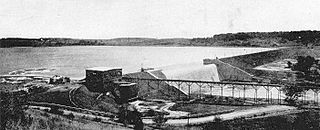
Hinckley Lake is located by Hinckley, New York. Originally dammed up to supply water to the Erie Canal, the lake provides municipal water supply to 130,000 people in the greater Utica, New York area, is a source of hydropower, and supports recreation during all seasons. The lake is located in the towns of Russia in Herkimer County, and Remsen in Oneida County. This body of water is one of many man made lakes in the Upstate NY region. Its sister lake is Delta Lake, also dammed up to supply water to the Erie Canal.
Laurel Run is a tributary of the Lackawanna River in Lackawanna County, Pennsylvania, in the United States. It is approximately 3.6 miles (5.8 km) long and flows through Jefferson Township and Archbald. The watershed of the stream has an area of 2.72 square miles (7.0 km2). The stream is somewhat affected by mine drainage. A reservoir known as the Laurel Run Reservoir is in the watershed and is dammed by the Cawley Dam. Waterfalls, ravines, ledges, and slides occur on some reaches of the stream. Additionally, the stream is a source of flooding in the borough of Archbald. Its drainage basin is designated as a Coldwater Fishery and a Migratory Fishery.

The Johnstown flood of 1977 was a major flood which began on the night of July 19, 1977, when heavy rainfall caused widespread flash flooding in Cambria County, Pennsylvania, United States, including the city of Johnstown and the Conemaugh Valley.
The Frank E. Heller Dam is an embankment dam that impounds Hagerman's Run and creates the Hagerman Reservoir that supplies water for Lycoming County, Pennsylvania. It is owned by the Williamsport Municipal Water Authority and Pennsylvania-American Water Company. Opened in 1975 it is located in Armstrong Township in southern Lycoming County.
Reservoirs storing large volumes of water have the capability of causing considerable damage and loss of life if they fail. Reservoirs are considered "installations containing dangerous forces" under international humanitarian law because of their potential adverse impact. In 1975 the failure of the Banqiao Reservoir Dam and other dams in Henan Province, China caused more casualties than any other dam failures in history. The disaster killed an estimated 171,000 people and 11 million people lost their homes.
